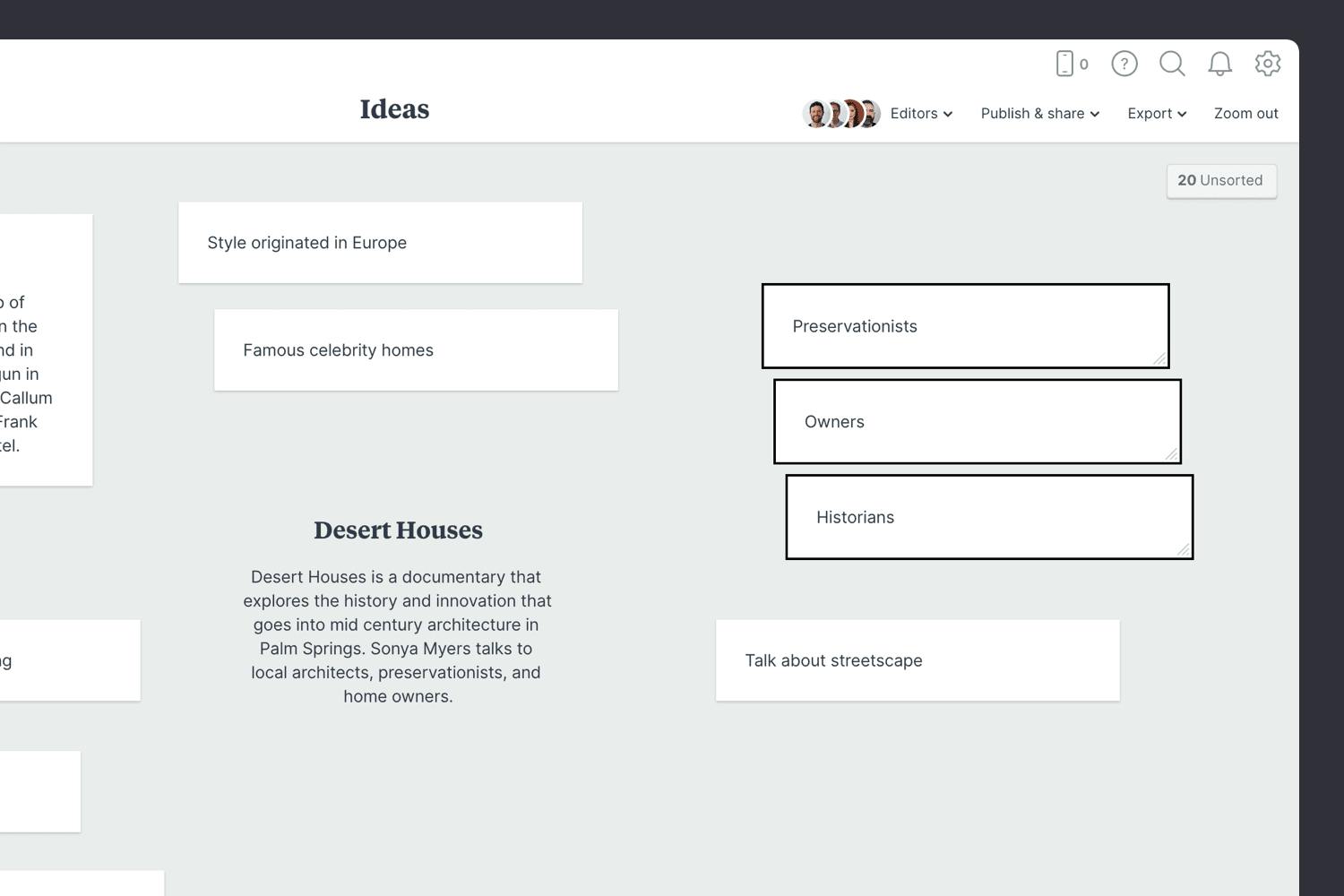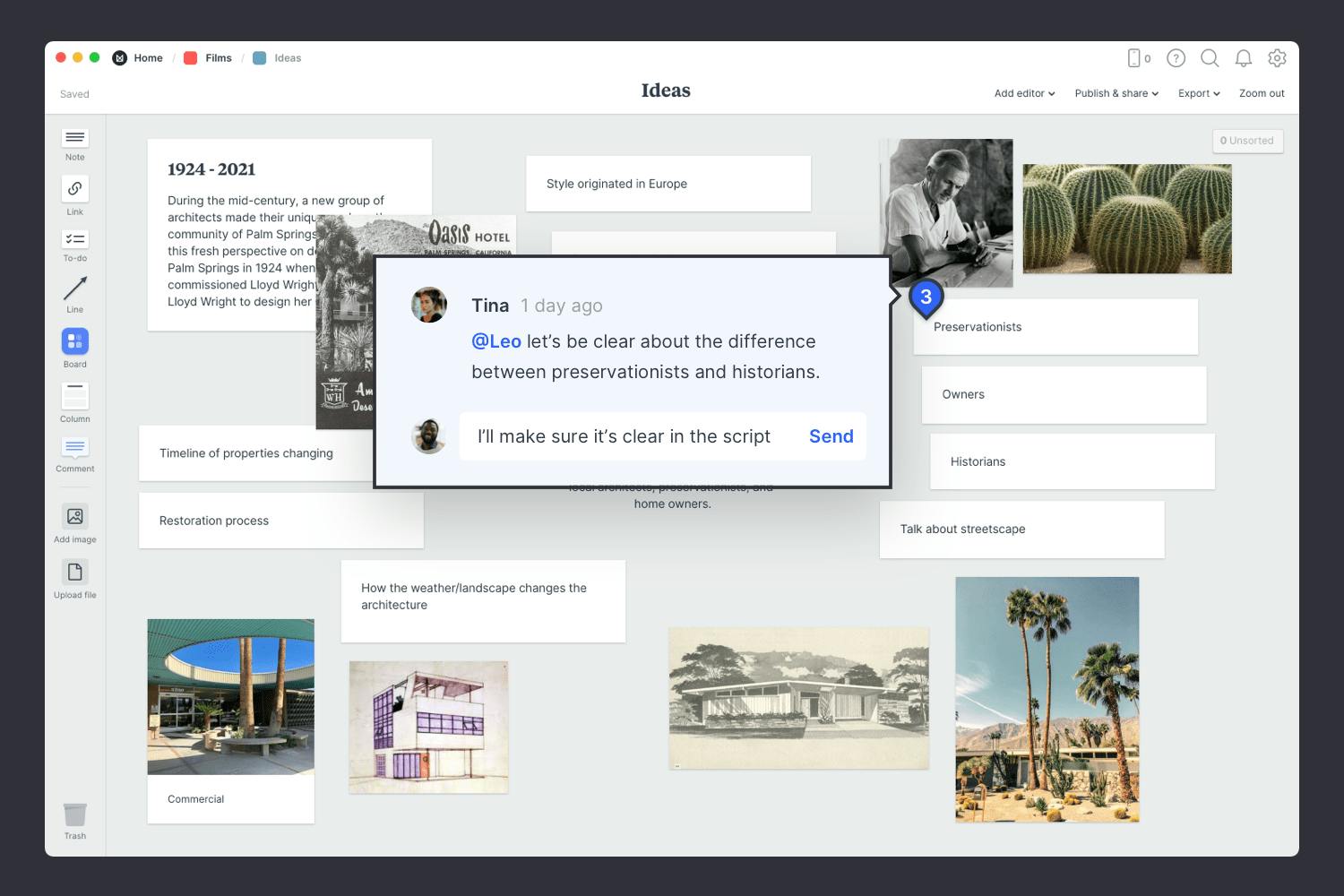Start Brainstorming
Get started for free with Milanote's easy to use brainstorming template.
Start BrainstormingSign up for free with no time limit
You have an idea for a film. It's just a spark at the moment, but you can't stop thinking about it. Now is the time to harness your creative energy and turn your idea into something real. And brainstorming is the perfect technique for the job.
You can use brainstorming to explore the topic for your film, dream up new characters, locations, or even the visual style you're after. It’s best thought of as a way to light up our imagination. As ancient philosopher Plutarch said, “The mind is not a vessel to be filled, but a fire to be kindled.”
In this guide, you'll learn the modern approach to brainstorming using Milanote. Remember, the creative process is non-linear, so you may find yourself moving back and forth between the steps as you go.
What's the idea or concept for your film? This is your starting point. It might be just a rough idea at the moment or a topic that you want to explore, but this process will help you see how far you can take it. Add a note that describes the film in 1 to 2 sentences to get started.

Create a new board for your brainstorming.
Drag a board out from the toolbar. Give it a name, then double click to open it.
Add a note to describe the concept of your film.
Start typing then use the formatting tools in the left hand toolbar.
Your initial idea doesn't need to be something groundbreaking, you'll transform it over time. As Steven Spielberg says "All good ideas start out as bad ideas, that's why it takes so long."
Next, invite others to brainstorm with you. They don’t have to be the people who will execute on the ideas but rather a diverse mix of thinkers. Brainstorming online means they can contribute from anywhere.
Director Joshua Fernandez says "Creativity is not the domain of one single person. Through free-association of thoughts and brainstorming, an accidental suggestion can be the best solution".

Invite others to add their ideas.
Open the "Editors" menu from the title bar of your board. Add email addresses of the people you'd like to collaborate with—they'll receive an invitation via email.
Now it's time to get creative. Start adding any ideas that relate to your initial concept. Think about the characters, their relationships, the locations you could use, visual styles and the history of the topic. Explore every thread until you fill the board.
Don't worry about evaluating your ideas yet, that will come later. Just add as many as you can. Setting a timer for 5 minutes is a great way to create a sense of urgency and prevent people from judging their thoughts.

Add a note for each idea.
Start typing then use the formatting tools in the left hand toolbar.
Don't allow killer phrases like “it’s too expensive, it’s too hard” to derail the brainstorm or judge ideas too quickly. As Alex Osborn said, “It is easier to tone down a wild idea than to think up a new one.”
Sometimes it's easier to communicate an idea with an image or video, especially if it's a mood or style you're trying to express. Gather reference imagery, videos and sound and add them into the mix. These can become the foundation for a moodboard as your film project evolves.

Use the built-in image library.
Search over 3 million beautiful photos powered by Pexels then drag images straight onto your board.
Drag images from your computer onto the board.
Click the "Upload file" button or just drag a file onto your board. You can add images, logos, documents, videos, audio and much more.
While research is the foundation of documentaries, it's also a great way to uncover ideas for fictional films. Think about how you could take an event from the past and weave it into your story, providing a fresh perspective on it. The more you know about the topic the more immersive and believable the story becomes.

Install the Milanote Web Clipper
Save content from other websites straight to your board.
Roll over an image (or highlight text), click Save, then choose the destination in Milanote. Return to your board and find the content in the "Unsorted" column on the right.
Now’s the time for critique. Run through the ideas again, this time critically evaluating them against the original concept.
Ask each person to choose their favourite ideas and explain why. Be prepared to share your thinking and welcome suggestions and improvements. Encourage constructive debate. If an idea isn't dramatically improving the story, put it aside. You can always return to it later.

Start a comment thread.
Drag out a comment from the toolbar on the left and place it on your board. Other editors can reply to your comment.
Mention teammates to get their attention.
Type '@' in any text field to mention someone who has access to your board. They'll receive a notification and be able to respond to your comment.
Once you've explore tangents and shared feedback, the next step is to make connections. This is where you see the magic of brainstorming.
Start by grouping similar ideas to uncover patterns in your thinking. Add a title to each group so it's easy to scan. You might find your ideas fall into groups like characters, costumes, locations or aesthetics but there are no rules about how you do it. Now you should start to see your initial concept coming to life.

Drag content to create groups of similar ideas
Now that your brainstorming session is complete, you have a strong foundation for your film! Remember, just as creativity and inspiration is constantly evolving, so are ideas. Come back and add to the brainstorm when inspiration strikes, or refer to it as you start your script. Use the template below to create start brainstorming in minutes or check out our full guide on how to plan a film.
